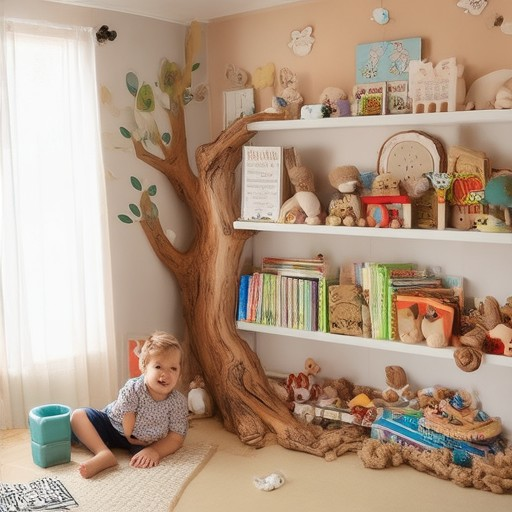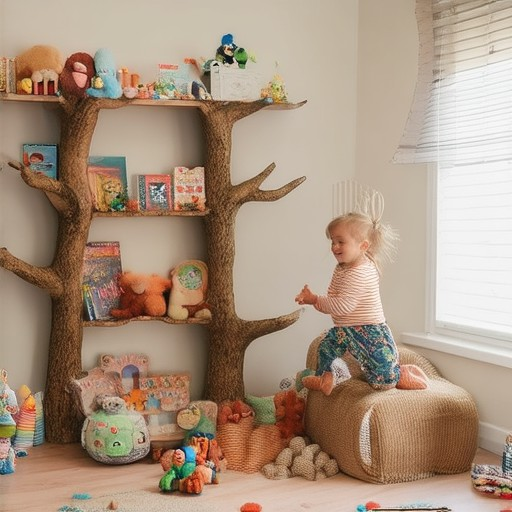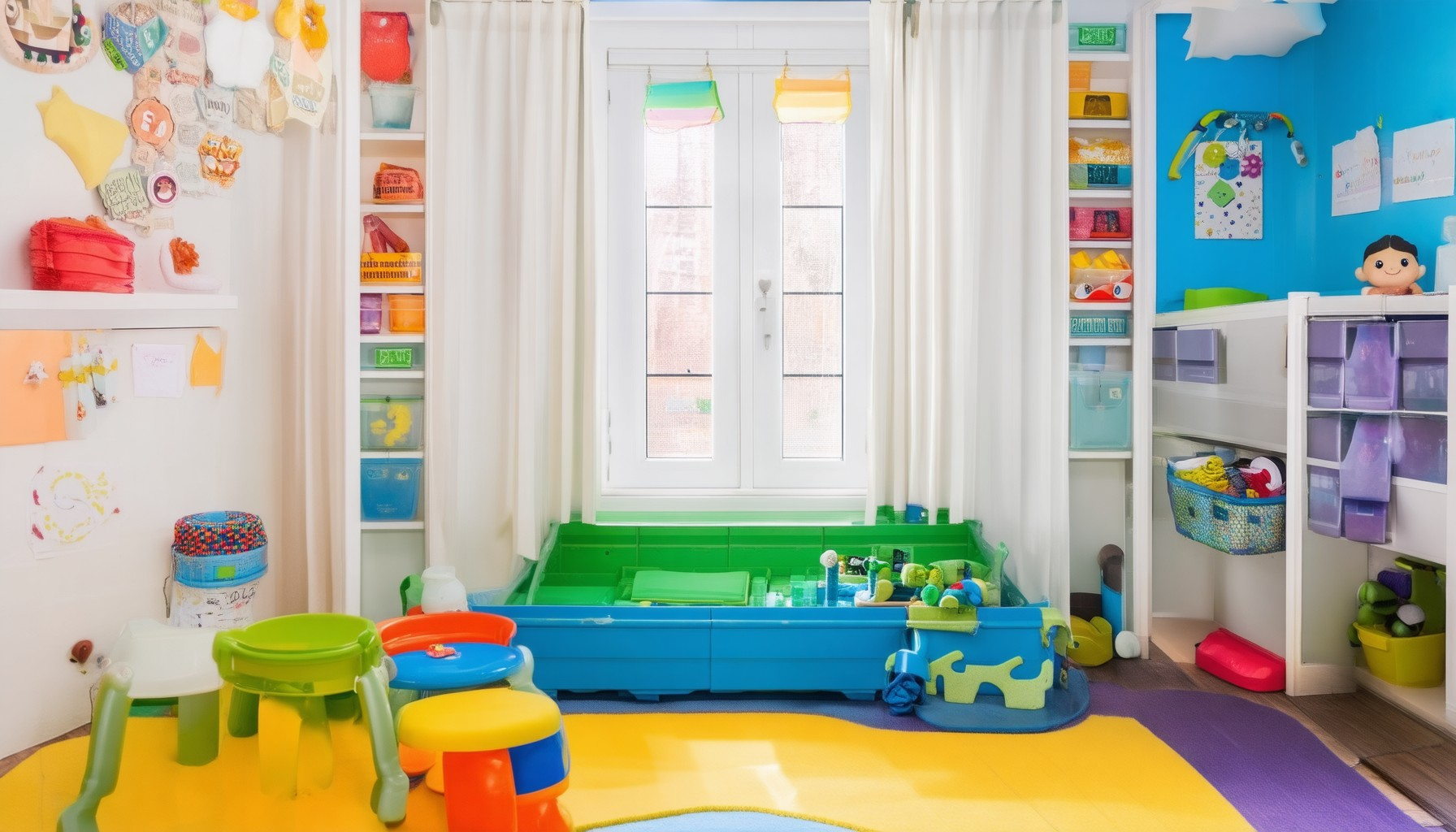Transforming a playroom into a functional, organized, and age-appropriate space can feel overwhelming, especially as your child grows and their needs evolve. Whether you’re revamping a playroom on a budget or seeking innovative storage solutions, creating a space that adapts to your family’s changing needs is essential. From Montessori-inspired setups to practical organization hacks, this guide explores how to redo a playroom that withstands the test of time. Discover tips on maximizing small spaces, exploring Waldorf-inspired designs, and finding clever ways to store toys while keeping the room tidy. With expert advice and creative ideas, revamping your playroom doesn’t have to be daunting—learn how to create a space that’s both fun and functional for years to come.
Key Takeaways
– Montessori Playrooms: Create a structured environment with ordered spaces, age-appropriate materials, and opportunities for sensorial learning to foster independence and concentration.
– Waldorf Playrooms: Design a simple, nature-inspired space using natural materials and vibrant colors to encourage imaginative, open-ended play and sensory exploration.
– Organization & Storage: Implement multi-functional furniture and thoughtful storage solutions to maximize space and keep playrooms tidy, supporting both Montessori and Waldorf philosophies.
– Practical Life Skills: Emphasize activities that build real-world skills, such as setting the table or organizing, to prepare children for daily routines and enhance motor skills.
– No Pretend Play in Montessori: Focus instead on hands-on learning, social harmony, and sensorial experiences to cultivate a love for learning and life skills.

How to Redo a Playroom
To redo a playroom effectively, consider these steps:
- Assess Current Condition : Evaluate the room’s layout, storage options, and safety features. Identify areas that need improvement, such as better organization or safety measures.
- Plan the Layout : Opt for an open layout to maximize space and activity. Consider a U-shaped arrangement to efficiently utilize the room.
- Choose a Color Scheme : Select vibrant, kid-friendly colors for walls, using washable paint. Incorporate wall decals or removable wallpaper for added personality.
- Install Durable Furniture : Select child-safe furniture with rounded edges. Include low coffee tables or Ottomans for versatility and storage.
- Improve Storage Solutions : Add shelves, cabinets, or baskets for toys and books. Utilize vertical space with tall bookshelves or hanging organizers.
- Enhance Lighting : Install flexible, adjustable lighting for various activities. Consider natural light during the day and ambient lighting in the evening.
- Add Interactive Elements : Create a chalkboard wall for creative play and include a toy storage bench with a lid. Rotate toys every few months to refresh the space.
- Organize Toys and Activities : Group similar toys together and use labeled bins for easy access. Offer age-appropriate toys that encourage imaginative play, such as dress-up areas or building sets.
- Include Safety Features : Use soft flooring materials and secure loose rugs. Install safety latches on drawers and cabinets to prevent accidents.
- Add Personal Touches : Introduce custom curtains or bedding for a cozy feel. Provide art supplies with aprons and smocks to keep kids clothed during play.
By focusing on functionality, safety, and creativity, you can transform a playroom into a dynamic, organized space tailored to a child’s needs.
What to Do with Playroom When Kids Get Older
When your children grow up and no longer need the playroom, it’s time to rethink its purpose. Here’s a thoughtful guide on transforming your playroom into a functional and enjoyable space for adults:
- Convert the Playroom into a Multipurpose Space
- Turn it into a home office for remote work or study with a desk and task lighting.
- Create a small gym with exercise equipment or yoga mats.
- Design a storage hub for clutter management, using shelves and bins.
- Consider adding a guest room or nursery if you’re expecting another child.
-
Declutter and Organize the Space
- Sort through toys, books, and other items to donate or sell what’s no longer needed.
- Use labeled bins or drawers for clothes, crafts, or seasonal items.
- Install shelving or cabinets to maximize vertical space.
- Clean and freshen the area to give it a new lease on life.
-
Repurpose the Room for Adult Needs
- Use it as a 娱乐室 (entertainment room) with a TV, sofa, and gaming console.
- Convert it into a 学习室 (study room) with a desk and bookshelves.
- Transform it into a 美容室 (beauty room) with a mirror and makeup table.
- Or, set it up as a 工作室 (workshop) for DIY projects and hobbies.
-
Renoir or Redesign the Room
- Update the paint colors to a calming palette that suits adult tastes.
- Add soft flooring or rugs for comfort.
- Install ambient lighting to create a cozy atmosphere.
- Consider adding plants or artwork to make the space more inviting.
-
Donate or Sell Unused Items
- Host a garage sale or list items on local classifieds or eBay.
- Donate gently used goods to charity organizations.
- Recycle old furniture or materials that can’t be reused.
By thoughtfully repurposing your playroom, you can create a space that serves the family well into the future. Let Peck and Gartner help you explore more ideas for home transformations and organization.

How to Make a Playroom Functional
To optimize a playroom for functionality and usability, consider the following organized approach:
- Organization Systems : Implement shelving units and bins to categorize toys by type. Use labels for easy identification. Install pegboards for hanging toys and accessories, maximizing vertical space efficiently.
- Layout Design : Create distinct zones for different activities. Dedicate an area for art supplies, another for reading, and a cozy corner for relaxation. Ensure there’s enough open space for movement and interactive play.
- Lighting Solutions : Incorporate ambient lighting options like overhead fixtures for general illumination and task lighting such as lamps or wall-mounted sconces for focused activities. Opt for energy-efficient bulbs to enhance safety and reduce heat.
- Furniture Choices : Select low-profile furniture like coffee tables or ottomans with built-in storage. Include a sturdy table for collaborative projects and consider multipurpose benches with hidden compartments for extra storage.
- Color and Decor : Use washable, hypoallergenic paints and choose soft, kid-friendly fabrics for curtains and cushions. Add wall decals or murals featuring child-safe themes to create an engaging environment without overwhelming the space.
- Interactive Learning Tools : Integrate educational toys and puzzles that promote critical thinking. Consider incorporating interactive displays or simple tech gadgets to blend learning with play.
- Safety Measures : Install childproof locks on cabinets and use secure, enclosed storage for small items. Add padding or corner protectors to soften edges and prevent injuries.
- Adaptability : Regularly rotate toys to keep the space fresh and introduce new elements based on your child’s evolving interests. Consider seasonal themes or themed zones that can evolve over time.
By focusing on these aspects, you can create a versatile and engaging playroom that adapts to your child’s needs while maintaining a clean and organized environment.

What is a Montessori Playroom?
A Montessori playroom is a thoughtfully designed environment tailored to support children’s learning and development. Rooted in the principles of Maria Montessori, it focuses on creating a space that fosters independence, concentration, and a love for learning.
Key Principles of a Montessori Playroom
- Order and Simplicity: The room is organized with clear boundaries and accessible materials to encourage self-directed play and learning.
- Age-Appropriate Materials: Toys, tools, and activities are selected to match the child’s developmental stage, promoting skill development at their own pace.
- Freedom Within Limits: Children are encouraged to explore and make choices within a structured environment that respects their natural curiosity.
- Sensorial Learning: The space incorporates sensory experiences through textures, colors, and shapes to aid in cognitive growth.
Design Considerations
- Floor Plan: Opt for open layouts that allow for easy movement and access to materials. Multi-functional furniture like shelves and storage boxes helps maximize space.
- Lighting: Use natural light during the day and soft, warm lighting in the evenings to create a calming atmosphere.
- Color Scheme: Stick to muted, earthy tones that reduce visual clutter and promote focus.
Essential Playroom Materials
- Matured toys that encourage imaginative play and problem-solving.
- Art supplies like paper, crayons, and watercolors for creative expression.
- Puzzles, matching games, and sorting activities to challenge cognitive skills.
- Natural materials such as wood, metal, and fabric to introduce texture and sensory experiences.
Activities and Routines
- Set aside dedicated time for work cycles, where children engage in purposeful activities like tidying or organizing.
- Encourage independent play, allowing children to choose activities that interest them.
- Guide rather than direct, respecting the child’s ability to solve problems and learn independently.
Creating a Montessori Atmosphere
- Keep conversations calm and positive to model emotional regulation.
- Provide opportunities for rest and relaxation to prevent overwhelm.
- Rotate toys every few weeks to maintain interest and reduce attachment to specific items.
By thoughtfully preparing a Montessori playroom, parents lay the foundation for a child’s journey of self-discovery, curiosity, and confidence.
What is a Waldorf Playroom?
A Waldorf playroom is a thoughtfully designed space tailored to foster creativity, learning, and sensory exploration for children. Rooted in the principles of Waldorf education, these environments emphasize simplicity, natural materials, and a connection to nature. The goal is to create a nurturing haven that encourages imaginative play, motor skills development, and a love for learning.
Key Characteristics of a Waldorf Playroom
- Simplicity : Toys and decor are handcrafted, often from natural materials like wood, cotton, and clay. The focus is on functionality over complexity.
- Natural Materials : Items are chosen with environmental and developmental benefits in mind, promoting tactile learning and sensory growth.
- Colorful and Harmonious : Soft, earthy tones and natural textures create a calming atmosphere that engages children’s senses.
- Open-ended Play : Toys and tools encourage creative problem-solving and storytelling, rather than prescriptive play.
Activities and Play Ideas
Waldorf-inspired playrooms often feature:- Dramatic Play Areas : Costumes, dolls, and props for role-playing scenarios.- Art and Craft Stations : Supplies like watercolors, paper, and natural dyes for creative expression.- Nature-Inspired Displays : Collections of plants, rocks, and seasonal items to spark curiosity.- Water Play : Troughs, containers, and pouring tools for sensory exploration.
Daily Routine in a Waldorf Playroom
Mornings often begin with gentle activities like watering plants or arranging flowers, setting a calm and intentional tone. Throughout the day, children engage in purposeful work, such as cleaning and organizing, which helps develop life skills. These routines mirror the rhythm of nature, teaching children patience and respect for the world around them.
By thoughtfully designing a Waldorf playroom, parents create a space that nurtures holistic development, fostering a deep connection to the world and a lifelong love of learning.

Why There Is No Pretend Play in Montessori?
Montessori education, developed by Maria Montessori, is centered around hands-on learning, sensorial experiences, and practical life skills. One aspect that sets Montessori apart from traditional approaches is its focus on real-life activities rather than imaginative play. Here are the reasons why pretend play is not a significant part of Montessori:
- Focus on Practical Life Skills :
Montessori classrooms are filled with activities that teach children practical life skills, such as setting the table, tying shoes, and folding laundry. These tasks help children develop motor skills, a sense of accomplishment, and an understanding of daily routines. Pretend play often takes a backseat to these skill-building exercises. - Concentration and Self-Discipline :
Montessori emphasizes concentration and self-discipline. Activities are designed to engage children deeply, often requiring focus and persistence. Pretend play, while engaging, may not always align with these goals, as it can sometimes lead to distractions or lack of focus. - Social Interaction and Guidance :
In Montessori settings, collaborative play is encouraged, but it is guided to foster empathy, respect, and cooperation. Unstructured pretend play might lead to conflicts or power struggles, which Montessori educators aim to minimize. Instead, they focus on activities that promote positive social interactions. - Sensorial Education :
Montessori places a strong emphasis on sensorial education, where children explore materials that stimulate their senses. This hands-on, tangible approach helps children understand the world around them. Pretend play, which is more abstract, takes a lesser role in this learning process. - Cultural Awareness :
Montessori curriculum incorporates stories and traditions from various cultures, teaching children about different ways of life. This holistic approach may leave less room for pretend play, as it is often more localized and personal. - Role of Imagination Elsewhere :
While pretend play is not central to Montessori, imagination is still encouraged through art, music, and storytelling. Children are allowed to express their creativity in meaningful ways that complement their learning experiences. - Environment Preparation :
Montessori classrooms are meticulously prepared with specific materials to facilitate certain types of learning. This structured environment may not require pretend play, as every activity has a clear purpose and function.
In summary, Montessori’s focus on practical, real-world preparation, along with its emphasis on concentration, social harmony, and sensorial exploration, explains why pretend play is not a primary component of the Montessori method. Instead, it fosters a foundation for future learning and life skills that are deeply rooted in everyday experiences.





0 Comments